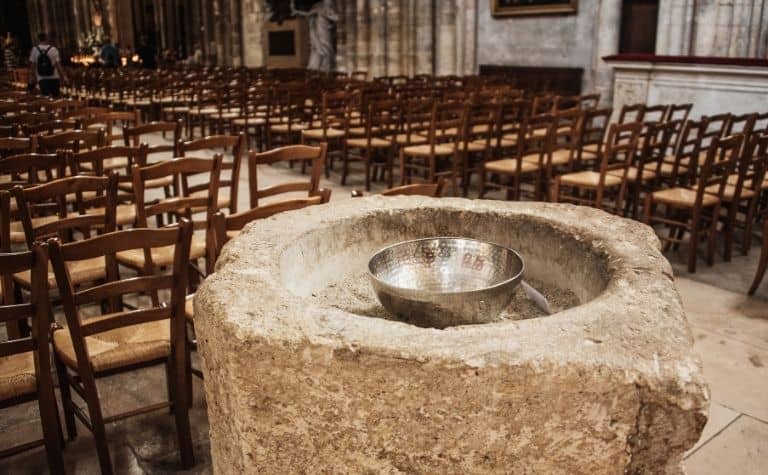Baptism is one of the most essential practices in Christianity, including in the Presbyterian tradition. Presbyterians take baptism very seriously because of its importance in the New Testament. Presbyterian churches are known for baptizing infants, but do they also baptize adults?
Presbyterians baptize adults in addition to infants, but they don’t re-baptize them. In most cases, ministers either sprinkle (aspersion) or pour water (affusion) on the head of an adult, though full-immersion baptisms do occur. The baptism ceremony occurs during a worship service because of what it signifies.
What do Presbyterians believe about adult baptism? Do Presbyterians believe a child or an adult has to be baptized in order to be saved? Why don’t Presbyterians believe in re-baptizing adults? Keep reading to learn more.
Also, see Presbyterian vs. Roman Catholic: What’s the Difference? to learn more.

What Do Presbyterians Believe About Baptism?
Most Christian traditions agree that baptism is essential, but some disagree about who should be baptized and why. Each position offers Bible-based arguments that best reflect their convictions and practices (example on Colossians 2:11-12 below).
The Presbyterian tradition teaches that baptism signifies community inclusion, isn’t necessary for salvation, and should be administered only once. The descriptions below are starting points for understanding the Presbyterian view.
- What does baptism signify? Baptism, like circumcision in the Old Testament, is a sign of community inclusion in the Presbyterian tradition. The children of Christian parents are to be baptized. The act of baptism alone doesn’t save a person, but God extends non-saving grace to the person, and the Holy Spirit’s work is recognized.
- Does baptism convey grace? Unlike Roman Catholic teaching, Presbyterians don’t believe baptism conveys God’s grace that produces instant regeneration. Unlike the Baptist tradition, Presbyterians don’t believe baptism is merely an outward sign of an inward reality. Instead, baptism is a means that conveys grace, which leads to salvation. Baptism doesn’t automatically save a person, according to Presbyterian teaching.
- Who should be baptized? Presbyterians practice “paedobaptism.” From the Latin word paedo, meaning “child,” the term refers to baptizing infants. Presbyterians also baptize adults, though they don’t re-baptize them (more below). (Also see Presbyterian vs. Reformed: What’s the Difference?)
- What is the mode of baptism? Presbyterians baptize infants by sprinkling their heads with water because young children can’t be fully immersed. Many Presbyterian churches and ministers are willing to perform full-immersion baptisms for adults, but some churches are limited in doing so because they don’t have baptismal tanks, only founts.
- Who can perform baptisms? Presbyterians believe only ordained pastors should baptize people and that it should occur in a church service because of its importance to the community. It isn’t a private affair but an event for the entire church family. Exceptions are possible for unique circumstances, such as being confined to a hospital due to illness.
- Do Presbyterians re-baptize? Presbyterians don’t re-baptize people, which is a contrast to Christian traditions, like Baptist. If a person has been baptized as an infant and lapses in their faith for a period of time, they don’t need to be re-baptized upon their return to faith and the Church (see below). (Also see Presbyterian vs. Baptist: What’s the Difference?)

Why Don’t Presbyterians Re-Baptize Adults?
Presbyterian churches baptize adults, but they don’t re-baptize them. This means that Presbyterian pastors don’t baptize an adult who has already been baptized, even if they lapse in their faith for years. (Also see Why Do Presbyterian Churches Have Red Doors?)
In contrast, in the Baptist tradition, churches will re-baptize people, especially those baptized as infants, who only later in life made a profession of faith. This position is known as “credobaptism.” The Latin word credo, meaning “I believe,” is the conviction that only professing believers, not infants, should be baptized.
The Presbyterian tradition’s reason for not re-baptizing people is based on these convictions:
- Community inclusion only occurs once: A person can only be initiated into a community once. Anything more is unnecessary. Even if a person spends a period of time away from the Church, their covenant membership is still active. Just like a person in the Old Testament wouldn’t be circumcised twice, even if they had spent time away from the covenant community, a person under the New Covenant wouldn’t be baptized twice.
- The Spirit’s work only occurs once and is sufficient: While baptism doesn’t save a person, the grace God extends through baptism leads to cleansing (Titus 3:5-7), regeneration (Rom. 2:28), justification (Rom. 4:11-12), and union with Christ (Gal. 3:21-29) isn’t lost due to a season of being lapse. God’s grace and the Spirit’s work, to many Presbyterians, are why the person has returned.
- Baptism isn’t about teaching the child at that moment: Presbyterians want people, even children, to understand their baptism, but that doesn’t need to occur before the event. Baptism can be a teaching moment for adults, but infant baptism has other purposes. An infant’s baptism is partly an expression of commitment by the parents and the church. As the child grows, so will their understanding of their baptism. Similarly, boys didn’t understand why they were circumcised under the Old Covenant but learned about its importance as they grew older.
- Re-baptism as a symbol of return isn’t biblical: Some Presbyterians argue that people in some churches that practice credobaptism are re-baptized as a visible marker of their return to their faith or the church. This isn’t, however, the meaning or purpose of baptism in the Presbyterian tradition. If a person has never been baptized, they should be. But if a person has been baptized previously, it is unnecessary to occur again. (Also see Presbyterian vs. Protestant: What’s the Difference?)

Different Perspectives On Colossians 2:11-12
Colossians 2:11-12 is an important passage to the paedobaptist and credobaptist positions. Historically, the Presbyterian tradition has used this passage to argue that infants should be baptized. Credobaptists, like the Baptist tradition, use the passages to defend their conviction that only professing believers should be baptized.
“In him also you were circumcised with a circumcision made without hands, by putting off the body of the flesh, by the circumcision of Christ, having been buried with him in baptism, in which you were also raised with him through faith in the powerful working of God, who raised him from the dead.” (Colossians 2:11-12, ESV)
What’s important to the Presbyterian position in this passage? Presbyterian teaching uses this passage to highlight the parallel between circumcision in the Old Covenant and baptism in the New Covenant.
The tradition argues that the circumcision of infants was the sign of the covenant community in the Old Testament, and baptizing infants is the sign of the covenant community in the New Testament.
The credobaptist response is that there are clear parallels between the two ceremonies. Still, there are stark differences, too, beginning with circumcision related to physical birth, while baptism corresponds to spiritual birth in the New Testament. (Also see Are Presbyterians Liberal?)
What’s important to the credobaptist position in this passage? Paul’s description of baptism to the recipients of this letter includes a reference to their faith.
He says the recipients were “buried with him in baptism,” and they were “raised with him through faith” (emphasis added). To credobaptists, this statement reveals that the recipients were professing believers when they were baptized.
The Presbyterian response is that the recipients may have been professing believers, but that doesn’t detract from the purpose God intends baptism to serve. (Also see Are Calvinists and Presbyterians the Same?)
References:
[1] Source
[2] Source
Related Questions
The Presbyterian and Baptist traditions are influential Protestant denominations that have left their mark in Europe, America, and worldwide. The traditions agree on many important matters of faith...
Protestant and Presbyterian are two terms associated with Christianity, but many people aren't sure what the differences are between them. Some people know that neither Protestants nor Presbyterians...
